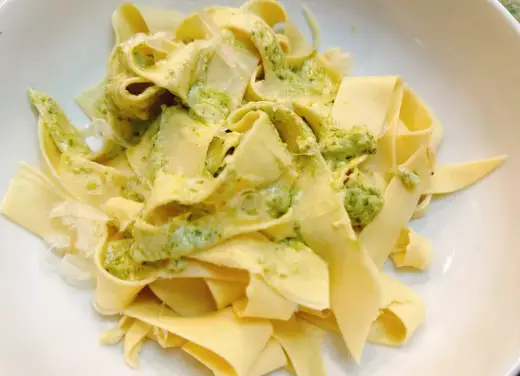There’s something truly special about homemade pasta – the satisfaction of creating something from scratch, the aroma of freshly kneaded dough, and the tender, toothsome texture that commercial pasta just can’t replicate. In this recipe, we’ll guide you through the process of making homemade pappardelle, a wide, ribbon-like pasta that pairs perfectly with rich sauces and hearty ragùs. With just a few simple ingredients and a bit of patience, you’ll soon be enjoying restaurant-quality pasta in the comfort of your own home. So dust off your pasta machine and let’s get started on this culinary adventure!
Ingredients:
Refrigerated:
- 2 large Eggs
Baking & Spices:
- 3/4 cup 00 flour
- 1/4 cup Semolina flour
Instructions:
- Prepare the Dough: In a large mixing bowl, combine the 00 flour and semolina flour. Create a well in the center of the flour mixture and crack the eggs into it.
- Knead the Dough: Using a fork or your fingers, gradually incorporate the flour into the eggs until a shaggy dough forms. Turn the dough out onto a clean, lightly floured surface and knead it for about 5-10 minutes, or until it becomes smooth and elastic. If the dough feels too dry, you can add a teaspoon of water at a time until it reaches the desired consistency.
- Rest the Dough: Once the dough is kneaded to perfection, wrap it tightly in plastic wrap and let it rest at room temperature for at least 30 minutes. This allows the gluten to relax, making the dough easier to roll out.
- Roll Out the Dough: After resting, divide the dough into smaller portions for easier handling. Using a pasta machine or a rolling pin, roll out each portion of dough into thin sheets, dusting lightly with flour as needed to prevent sticking. Aim for a thickness of about 1/16 inch (1.5 mm).
- Cut the Pappardelle: Once the dough is rolled out, generously flour it to prevent sticking, then loosely roll it up into a cylinder. Use a sharp knife to slice the rolled dough into wide ribbons, about 3/4 inch (2 cm) wide, to create your pappardelle.
- Cook the Pasta: Bring a large pot of salted water to a boil. Add the freshly cut pappardelle to the boiling water and cook for 2-3 minutes, or until al dente. Keep a close eye on the pasta as it cooks, as fresh pasta cooks much faster than dried pasta.
- Serve and Enjoy: Once cooked, drain the pappardelle and toss it with your favorite sauce, whether it’s a classic marinara, a creamy Alfredo, or a hearty Bolognese. Garnish with freshly grated Parmesan cheese and a sprinkle of chopped parsley, if desired, and serve immediately.
Cook Notes and Variations:
- Flour Variations: While this recipe calls for a combination of 00 flour and semolina flour, you can experiment with different types of flour to achieve the desired texture and flavor. All-purpose flour or bread flour can be used as substitutes for 00 flour, while durum wheat flour can replace semolina flour.
- Eggless Option: If you’re looking to make eggless pappardelle, simply omit the eggs from the recipe and adjust the amount of flour and water as needed to form a smooth dough.
- Flavor Additions: For added flavor, consider incorporating herbs or spices into the dough, such as chopped fresh basil, thyme, or cracked black pepper.
FAQs (Frequently Asked Questions):
Q: Can I make the dough by hand without a pasta machine? A: Absolutely! While a pasta machine makes the process quicker and more uniform, you can certainly roll out the dough by hand using a rolling pin. Just be sure to roll it as thinly and evenly as possible for the best results.
Q: How do I store homemade pappardelle? A: Once the pappardelle is cut, you can dry it on a drying rack or lightly floured baking sheet for 1-2 hours, then transfer it to an airtight container and store it in the refrigerator for up to 3 days. Alternatively, you can freeze the fresh pasta for up to 2-3 months.
Q: Can I make flavored pappardelle, like spinach or tomato pasta? A: Yes, you can add flavorings such as puréed spinach or tomato paste to the dough to create colorful and flavorful variations of pappardelle. Just be sure to adjust the amount of liquid and flour accordingly to maintain the proper dough consistency.
Q: How can I achieve a rustic, hand-cut look for the pappardelle? A: To achieve a more rustic, irregular look for the pappardelle, you can hand-cut the dough using a sharp knife rather than a pasta machine. This will result in slightly thicker and more uneven noodles, adding to the homemade charm of the dish.
Keto and Low Carb Versions:
For those following a keto or low-carb diet, traditional pasta made with flour is not suitable. However, you can still enjoy a keto-friendly version of pappardelle using the following substitutions:
- Almond Flour: Replace the 00 flour and semolina flour with almond flour or a combination of almond flour and coconut flour for a low-carb alternative.
- Egg and Psyllium Husk: Use a combination of eggs and psyllium husk powder to bind the dough together and create a pasta-like texture without the need for traditional flour.
- Zucchini Noodles: For a completely grain-free option, use spiralized zucchini noodles as a base for your pappardelle dish, tossing them with your favorite keto-friendly sauce and toppings.
Homemade pappardelle is a simple yet satisfying pasta that elevates any meal with its fresh flavor and tender texture. With just a few basic ingredients and some hands-on effort, you can create a culinary masterpiece that rivals the finest Italian trattorias. Whether you’re a seasoned pasta enthusiast or a novice home cook looking to expand your repertoire, this recipe is sure to impress. So roll up your sleeves, channel your inner nonna, and enjoy the delicious rewards of homemade pasta perfection!



